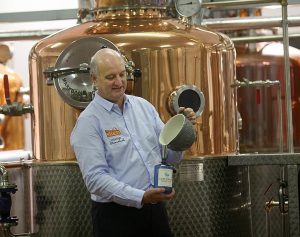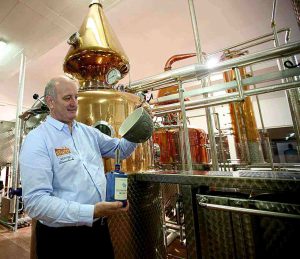Pat Rigney – Drinks Ireland|Spirits’ new Chairman from The Shed

“The level of pride and affection for our gin producers in creating jobs in rural Ireland, in pulling communities together around these ventures, might be better reflected by government going forward.” – Pat Rigney.
As the new Chairman of Drinks Ireland|Spirits Pat Rigney’s role lies in representing the (non-whiskey) spirits industry here, predominantly gin, cream liqueurs and poitín.
Most of the work involved in facilitating and supporting the spirits industry as a group is done by the executive, he points out, “My role is as facilitator and to be the face of the spirits industry for the next two years.”
The total value of the Island of Ireland spirits market has been put at €1.43 billion of which the RoI is responsible for just over €1 billion so our spirits industry continues to perform strongly.
And the future seems bright, he agrees, but there are caveats.
Bearing in mind the potential for spirits growth in the US could tariffs have come at a worse time?
US-EU tariffs
Cream liqueurs in the US are under a 25% tariff at the moment and due for review on the 15th of this month, he says, adding, “That 25% tariff is a concern and there’s potential for that to increase on the 15th. Irish whiskey is back on the list to be reviewed on the 15th too which is also a concern. I hope the tariffs are removed rather than increased!
“50% of all the growth in Irish whiskey comes from the US, so it’s a very important market for us.”
And then there are also the implications of the direction in which Brexit seems to be going…
Brexit
Again he remains focused on potential tariffs.
“The challenge on Brexit is more to do with making sure that zero tariffs exist between the UK and the EU,” says Pat, “We must also find a way of dealing with those brands parts of which are made in NI or where sub-components and parts travel across the border.”
Drinks Ireland is making a submission to government on how it might manage this.
Exporting spirits elsewhere
On the positive side, we’ve 31 operational distilleries and 20 in planning – that’s a lot of commitment to the spirits industry and the big focus now has to be on everyone creating brands that are going to succeed not just in Ireland but internationally, he believes, “Building the distillery is just the first part of the journey.”
And there’s no shortage of markets to conquer.
With single market countries in Central Europe and countries further east offering growth potential for Irish spirits, perhaps a diversification away from the US and UK might be one direction that we could take.
The sales figures for last year hint at countries to the east emerging as a strong and sustainable counterbalance to the North American market in these turbulent times for free trade.
So in light of the US and the UK, is it a case now of “Look East young spirits exporter?”
Pat looks doubtful that this will prove a panacea for Irish spirits exporters.
“The US will always be a very important strategic market for us regardless of what happens on tariffs,” he points out, “North America will continue to be our priority.
“As for the UK, my sense is that we’ll come to a good arrangement.
“Yet in eastern Europe and Russia some very exciting things are happening for our brands just as they are in Australia and New Zealand and even Asia (although that’s a somewhat slower burner),” he admits.
“Gin globally is in different levels of growth in mature markets like France, Belgium, Holland, the Benelux countries and other parts of Continental Europe. It’s still growing in the UK and Ireland but it’s beginning to get to the stage where we can expect smaller levels of growth.
“The US has seen growth in premium product but a decline at the value end.
“Asia is beginning to grow too so it’s a bit of a mixed bag. The big challenge is to break through whether in mature, growing or emerging markets – and finding a brand that’s going to connect with the consumers there.
“Many parts of the world say ‘not another gin, please’ so we need something very special to break through all of that.”
Domestic spirits sales
Spirits sales in the home market increased by 6.6% in 2018 from 2.25 million nine-litre cases in 2017 to 2.40 million cases.
Domestic spirits consumption seems therefore to be on a healthier footing of late.
Total alcohol consumption was up 1.8% in 2018 vs 2017, he says. “But the amount of adults increased as well by 1.7% so average volume consumption remains flat. Within that, gin has grown to 13% of the spirits market, Irish whiskey 26%, vodka 34% and rum 7%.
“Overall therefore, it has been a good year for spirits. But there was a fall in tourism towards the latter part of the year which would have affected some parts of that market and – added to the uncertainty in 2020 around Brexit and tariffs – we’ve now got the Corona virus which might impact negatively on travel, but I’m hoping that it will be another strong year for the spirits industry – nevertheless, there are challenges out there.”
It’s interesting to note that where spirits held 19.8% of Ireland’s drinks market in 2017, they crossed the 20% border for the first time in over a decade in 2018 driven by consumer demand for Irish whiskey and gin. Gin sales rocketed again last year, up by 31.8%, maintaining its position as the fastest-growing spirit in the domestic market.
But vodka remains Ireland’s favourite spirits drink at 34% of the spirits market here, up by 4.8% between 2017 and 2018.
Outside Ireland however the vodka picture may be changing.
“Vodka’s going through mixed fortunes around the world. It’s probably flat in Ireland and in the US – much of it is down with the exception of Tito’s Handmade which continues to do very well – the breakthrough brand that‘s broken all the rules.”
And in Ireland itself some things never change – like excise duty.
Excise not looking at the bigger picture
What can a Government realistically do to replace a €372.2 million cash cow like excise – a cash cow that’s grown up a little more from 2017’s figure of €353 million? How could it possibly consider letting this particular cow go through a 15% weight reduction?
“You’ve got to look at the bigger picture,” he responds, “What’s fair? What’s reasonable with a real eye on tourism?
“Are we really aligning ourselves with our European partners in Continental Europe? Our alcohol excise is four times that of Spain, three times that of Germany and significantly higher than the UK.
“It’s just unreasonable and unfair at present. Also, with our burgeoning new distilleries, it’s important to build a strong home market and this level of excise and VAT combined makes it very difficult for emerging companies to do this.”
With most Irish spirits being purchased via the off-trade, only 25% of spirits by volume are purchased through the on-trade but the on-trade’s responsible for 58% of spirits sales by value. How can we encourage more on-trade sales?
“A key driver of increased spirits sales is developing cocktail and spirit drink lists with flair and discovery,” he believes, “Build events around these by inviting in the owners and/or suppliers.
“Also, feature brands on a monthly basis. Staff training and customer masterclasses should be ongoing – and work the premium end of the market with a spirits range having depth and variety.”
Finally, the serve: he exhorts mixologists to use a top class glass, real ice cubes, “… garnish it and serve it with interest and aplomb”.
“There’s great pride in our industry,” he concludes, “The vast majority of people – both consumers and people working in the industry – are proud of the craftsmanship and restoration of skills and long-lost traditions. I think it’s important that the government recognises this level of pride and affection for our brands by investing in rural setups like The Shed Distillery and others and supporting them.
“The level of pride and affection for our gin producers in creating jobs in rural Ireland, in pulling communities together around these ventures, might be better reflected by government going forward,” he suggests.
It remains to be seen whether our new government will see it this way or whether Pat’s will remain but a pipe dream.

“Building the distillery is just the first part of the journey.”








